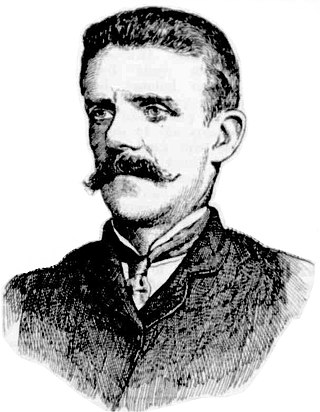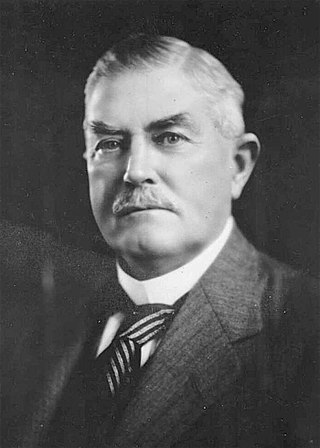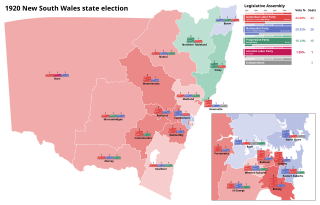Related Research Articles
Members of the New South Wales Legislative Assembly who served in the 53rd parliament held their seats from 2003 to 2007. They were elected at the 2003 state election, and at by-elections. The Speaker was John Aquilina.
Members of the New South Wales Legislative Assembly who served in the 27th parliament of New South Wales held their seats from 1925 to 1927. They were elected at the 1925 state election on 30 May 1925. The Speaker was James Dooley.
Members of the New South Wales Legislative Assembly who served in the 26th parliament of New South Wales held heir seats from 1922 to 1925. They were elected at the 1922 state election on 25 March 1922. The Speaker was Daniel Levy.
Members of the New South Wales Legislative Assembly who served in the 25th parliament of New South Wales held their seats from 1920 to 1922. They were elected at the 1920 state election on 20 March 1920. The Speaker was Daniel Levy with the exception of 13–20 December 1921 when he was replaced by Simon Hickey.
Members of the New South Wales Legislative Assembly who served in the 23rd parliament of New South Wales held their seats from 1913 to 1917. They were elected at the 1913 state election on 6 December 1913. The Speaker was Richard Meagher.
Members of the New South Wales Legislative Assembly who served in the 24th parliament of New South Wales held their seats from 1917 to 1920. They were elected at the 1917 state election on 24 March 1917. Speaker was John Cohen until 19 August 1919 when he was succeeded by Daniel Levy.

Alfred Edden was a politician, trade union organiser and coal miner in New South Wales, Australia. He was a member of the New South Wales Legislative Assembly for more than 28 years, including 3 as Secretary for Mines. He was a foundation member of the Labor Party but left the party twice, in 1891 over the question of the solidarity pledge and was expelled in 1916 over the question of conscription.
Wilfred Joseph "Bill" Ratcliffe was an Australian politician. He was a Labor Party member of the New South Wales Legislative Assembly from 1922 until 1932, representing the districts of Botany (1922–1927), Alexandria (1927–1930) and Barwon (1930–1932). He was Secretary of Public Works and Minister for Railways for four months in 1927, during the last months of the first Lang government.
Members of the New South Wales Legislative Assembly who served in the 55th parliament held their seats from 2011 to 2015. They were elected at the 2011 state election and at by-elections. The Speaker was Shelley Hancock.
Sydney, an electoral district of the Legislative Assembly in the Australian state of New South Wales, has had two incarnations, the first from 1920 to 1927 as a five-member electorate, the second from 2007 to the present as a single-member electorate.

The Holman ministry , also known as the Second Holman ministry or Holman Nationalist ministry was the 36th ministry of the New South Wales Government, and was led by the 19th Premier, William Holman.

Richard Thomas Ball was a politician and engineer in New South Wales, Australia.
Patrick Joseph Minahan, was an Irish-born Australian politician.

The 1922 New South Wales state election was held on 25 March 1922. This election was for all of the 90 seats in the 26th New South Wales Legislative Assembly and it was conducted in multiple member constituencies using the Hare Clark single transferable vote. The 25th parliament of New South Wales was dissolved on 17 February 1922 by the Governor, Sir Walter Edward Davidson, on the advice of the Premier James Dooley.

The 1920 New South Wales state election was held on 20 March 1920. The 24th parliament of New South Wales was dissolved on 18 February 1920 by the Governor, Sir Walter Edward Davidson, on the advice of the Premier William Holman. The election was for all of the 90 seats in the 25th New South Wales Legislative Assembly, and it was the first to be conducted with multi-member electorates, using the Hare-Clark single transferable vote system.
This is a list of candidates for the 1920 New South Wales state election. The election was held on 20 March 1920. The election was the first of three conducted under the system of proportional representation; as a result, it is not possible to estimate the notional pre-election numbers.
The 1922 New South Wales state election was for 90 seats representing 24 electoral districts, with each district returning between 3 and 5 members. This was the second election in New South Wales that took place under a modified Hare-Clark voting system. The average number of enrolled voters per member was 13,785, ranging from Sturt (10,386) to Ryde (15,722).
The 1920 New South Wales state election was for 90 seats representing 24 electoral districts, with each district returning between 3 and 5 members. This was the first election in New South Wales that took place under a modified Hare-Clark voting system. The average number of enrolled voters per member was 12,805, ranging from Sturt (11,539) to Sydney (13,478).
Eastern Suburbs, an electoral district of the Legislative Assembly in the Australian state of New South Wales was created in 1920 and abolished in 1927.
Sturt, an electoral district of the Legislative Assembly in the Australian state of New South Wales, had two incarnations, from 1889 until 1968 and from 1971 until 1981.
References
- ↑ Green, Antony. "1922 Election candidate index". New South Wales Election Results 1856-2007. Parliament of New South Wales . Retrieved 2 November 2019.
- ↑ "The ALP: definite action taken against candidates who sign pledges". The Sydney Morning Herald . 10 March 1920. p. 11. Retrieved 2 November 2019– via National Library of Australia.